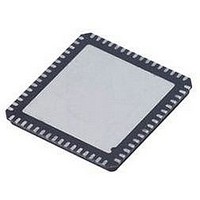AD9267BCPZ Analog Devices Inc, AD9267BCPZ Datasheet - Page 21

AD9267BCPZ
Manufacturer Part Number
AD9267BCPZ
Description
IC MOD SIGMA-DELTA DUAL 64LFCSP
Manufacturer
Analog Devices Inc
Datasheet
1.AD9267BCPZRL7.pdf
(24 pages)
Specifications of AD9267BCPZ
Applications
*
Mounting Type
Surface Mount
Package / Case
64-LFCSP
Resolution (bits)
16bit
Sampling Rate
640MSPS
Input Channel Type
Differential
Data Interface
Serial, SPI
Supply Voltage Range - Analog
1.7V To 1.9V
Supply Voltage Range - Digital
1.7V To 1.9V
Lead Free Status / RoHS Status
Lead free / RoHS Compliant
APPLICATIONS INFORMATION
FILTERING REQUIREMENT
The need for anti-alias protection often requires one or two
octaves for a transition band, which reduces the usable
bandwidth of a Nyquist converter to between 25% and 50% of
the available bandwidth. A CT Σ-Δ converter maximizes the
available signal bandwidth by forgoing the need for an
antialiasing filter because the architecture possesses inherent
antialiasing. Although a high order, sharp cutoff antialiasing
filter may not be necessary because of the unique characteristics
of the architecture, a low order filter may still be required to
precede the ADC for out-of-band signal handling.
Depending on the application and the system architecture, this
low order filter may or may not be necessary. The signal
transfer function (STF) of a continuous time feedforward ADC
usually contains out-of-band peaks. Because these STF peaks
are typically one or two octaves above the pass-band edge, they
are not problematic in applications where the bulk of the signal
energy is in or near the pass band. However, in applications
with large far-out interferers, it is necessary to either add a filter
to attenuate these problematic signals or to allocate some of the
ADC dynamic range to accommodate them.
Figure 43 shows the normalized STF of the AD9267 CT Σ-Δ
converter. The figure shows out-of-band peaking beyond the
band edge of the ADC. Within the 10 MHz band of interest, the
STF is maximally flat with less than 0.1 dB of gain. Maximum
peaking occurs at 60 MHz with 10 dB of gain. To put this into
perspective, for a fixed input power, a 5 MHz in-band-signal
appears at −5 dBFS, a 25 MHz tone appears at −2 dBFS and
60 MHz tone at +5 dBFS. Because the maximum input to the
ADC is −2 dBFS, large out-of-band signals can quickly saturate
the system. This implies that under these conditions, the digital
outputs of the ADC no longer accurately represents the input.
Refer to the Overrange (OR) Condition section for details on
overrange detection and recovery.
15
13
–1
–3
–5
11
9
7
5
3
1
0
10
20
30
FREQUENCY (MHz)
Figure 43. STF
40
50
60
70
80
90
100
Rev. 0 | Page 21 of 24
Figure 43 shows the gain profile of the AD9267 and this can be
interpreted as the level in which the signal power should be
scaled back to prevent an overload condition. This is the
ultimate trip point and before this point is reached, the in-band
noise (IBN) slowly degrades. As a result, it is recommended that
the low-pass filter be designed to match the profile of Figure 44,
which shows the maximum input signal for a 3 dB degradation
of in-band noise. The input signal is attenuated to allow only
3 dB of noise degradation over frequency.
The noise performance is normalized to a −2 dBFS in-band
signal. The AD9267 STF and NTF are flat within the band of
interest and should result in almost no change in input level and
IBN. Beyond the bandwidth of the AD9267, out-of-band
peaking adds gain to the system, therefore requiring the input
power to be scaled back to prevent in-band noise degradation.
The input power is scaled back to a point where only 3 dB of
noise degradation is allowed, therefore resulting in Figure 44.
An example third-order low-pass Chebyshev II type filter is
shown in Figure 45 and the corresponding magnitude vs.
frequency response of the filter is shown in Figure 44.
39pF
C1
–10
–15
–20
–25
Figure 44. Maximum Input Level for 3 dB Noise Degradation
–5
5
0
0
Figure 45. Third-Order Low-Pass Chebyshev II Filter
10
180nH
390pF
180nH
390pF
C2
C2
L1
L1
20
CHEBYSHEV II
FILTER RESPONSE
30
FREQUENCY (MHz)
40
C3
220pF
50
VIN+
VIN–
60
+85°C
–40°C
70
1kΩ
+25°C
80
AD9267
CT Σ-Δ
90
AD9267
100






